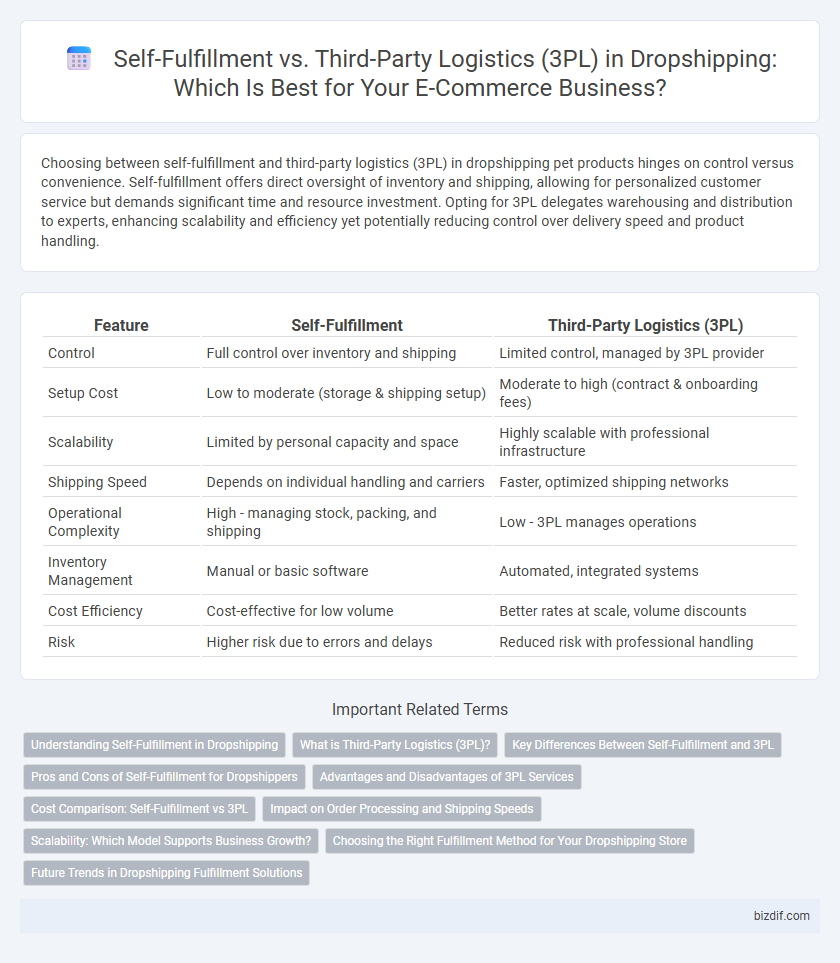Choosing between self-fulfillment and third-party logistics (3PL) in dropshipping pet products hinges on control versus convenience. Self-fulfillment offers direct oversight of inventory and shipping, allowing for personalized customer service but demands significant time and resource investment. Opting for 3PL delegates warehousing and distribution to experts, enhancing scalability and efficiency yet potentially reducing control over delivery speed and product handling.
Table of Comparison
| Feature | Self-Fulfillment | Third-Party Logistics (3PL) |
|---|---|---|
| Control | Full control over inventory and shipping | Limited control, managed by 3PL provider |
| Setup Cost | Low to moderate (storage & shipping setup) | Moderate to high (contract & onboarding fees) |
| Scalability | Limited by personal capacity and space | Highly scalable with professional infrastructure |
| Shipping Speed | Depends on individual handling and carriers | Faster, optimized shipping networks |
| Operational Complexity | High - managing stock, packing, and shipping | Low - 3PL manages operations |
| Inventory Management | Manual or basic software | Automated, integrated systems |
| Cost Efficiency | Cost-effective for low volume | Better rates at scale, volume discounts |
| Risk | Higher risk due to errors and delays | Reduced risk with professional handling |
Understanding Self-Fulfillment in Dropshipping
Self-fulfillment in dropshipping involves the seller managing inventory storage, order processing, and shipping directly, allowing greater control over product quality and customer experience. This method requires a reliable system for inventory tracking and shipping logistics to avoid delays and stockouts, essential for maintaining competitive delivery times. Compared to third-party logistics (3PL), self-fulfillment can reduce costs but demands more hands-on management and operational resources.
What is Third-Party Logistics (3PL)?
Third-Party Logistics (3PL) refers to outsourcing supply chain management and fulfillment services to specialized companies that handle warehousing, inventory management, order processing, and shipping. 3PL providers offer scalable solutions for dropshipping businesses, reducing operational complexity and enabling faster delivery through established carrier networks. Leveraging 3PL can improve order accuracy, lower shipping costs, and enhance customer satisfaction, making it a strategic choice for e-commerce growth.
Key Differences Between Self-Fulfillment and 3PL
Self-fulfillment requires merchants to handle inventory storage, order processing, and shipping independently, offering full control but higher time investment. Third-Party Logistics (3PL) providers manage warehousing, packing, and shipping on behalf of businesses, enabling scalable operations and reduced fulfillment errors. Major differences include control level, operational complexity, cost structure, and scalability potential, impacting dropshipping efficiency and customer satisfaction.
Pros and Cons of Self-Fulfillment for Dropshippers
Self-fulfillment in dropshipping offers complete control over inventory management and packaging quality, allowing sellers to customize customer experiences and reduce dependency on external parties. However, it demands significant time investment, storage capacity, and operational expertise, potentially leading to delayed shipping and increased overhead costs. This approach suits sellers aiming for brand differentiation but may limit scalability compared to leveraging third-party logistics (3PL) services.
Advantages and Disadvantages of 3PL Services
Third-Party Logistics (3PL) services offer advantages such as scalable storage solutions, professional inventory management, and streamlined shipping processes that reduce operational complexity for dropshipping businesses. However, reliance on 3PL can lead to less control over order fulfillment speed and product handling, potentially impacting customer satisfaction and increasing costs due to service fees. Choosing 3PL enables businesses to focus on marketing and growth while outsourcing logistics, but it requires careful provider selection to balance efficiency with service quality.
Cost Comparison: Self-Fulfillment vs 3PL
Self-fulfillment often incurs lower upfront costs by eliminating third-party fees but increases expenses related to storage, packaging, and labor. Third-Party Logistics (3PL) providers charge fees for warehousing, order processing, and shipping, which can scale with order volume, potentially reducing per-unit costs. Evaluating cost-effectiveness requires analyzing order frequency, inventory management expenses, and shipping rates specific to each fulfillment method.
Impact on Order Processing and Shipping Speeds
Self-fulfillment allows dropshippers to maintain direct control over order processing, often resulting in faster handling times and personalized packaging. Third-Party Logistics (3PL) providers optimize shipping speeds by leveraging established distribution networks and bulk shipping discounts, reducing delivery times for high-volume orders. Choosing between self-fulfillment and 3PL significantly impacts order accuracy, shipping speed, and customer satisfaction in dropshipping operations.
Scalability: Which Model Supports Business Growth?
Self-fulfillment offers direct control but often limits scalability due to inventory constraints and time-intensive order management, making rapid expansion challenging. Third-Party Logistics (3PL) providers leverage advanced warehousing, automation, and extensive distribution networks to efficiently handle increasing order volumes and diverse product lines. Businesses aiming for scalable growth typically benefit from 3PL solutions that streamline operations and adapt quickly to market demands.
Choosing the Right Fulfillment Method for Your Dropshipping Store
Choosing the right fulfillment method for your dropshipping store hinges on factors such as control, cost, and scalability. Self-fulfillment offers direct oversight and customization at potentially higher labor and storage costs, while third-party logistics (3PL) providers streamline operations with warehousing and shipping expertise, enabling faster delivery and reduced workload. Evaluate order volume, budget, and customer experience priorities to determine whether self-fulfillment or 3PL best aligns with your business growth goals.
Future Trends in Dropshipping Fulfillment Solutions
Future trends in dropshipping fulfillment solutions emphasize automation and AI-driven inventory management to enhance efficiency and reduce errors. Integrating advanced third-party logistics (3PL) platforms with real-time data analytics allows for seamless order processing and faster shipping times, crucial for meeting growing customer expectations. Self-fulfillment remains relevant for niche markets prioritizing control and customization, but the scalability and technological advantages of 3PL providers are driving widespread adoption in the evolving e-commerce landscape.
Self-Fulfillment vs Third-Party Logistics (3PL) Infographic

 bizdif.com
bizdif.com